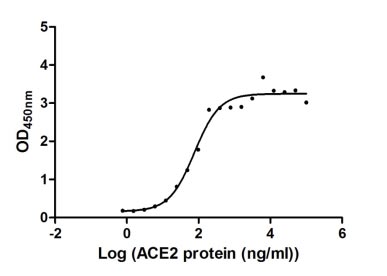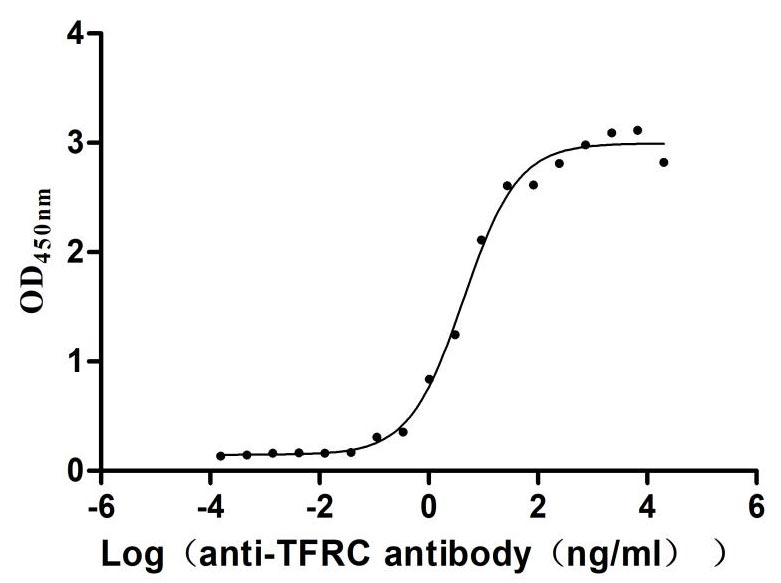Recombinant Human Serine palmitoyltransferase 1 (SPTLC1), partial
-
货号:CSB-YP022639HU1
-
规格:
-
来源:Yeast
-
其他:
-
货号:CSB-EP022639HU1
-
规格:
-
来源:E.coli
-
其他:
-
货号:CSB-EP022639HU1-B
-
规格:
-
来源:E.coli
-
共轭:Avi-tag Biotinylated
E. coli biotin ligase (BirA) is highly specific in covalently attaching biotin to the 15 amino acid AviTag peptide. This recombinant protein was biotinylated in vivo by AviTag-BirA technology, which method is BriA catalyzes amide linkage between the biotin and the specific lysine of the AviTag.
-
其他:
-
货号:CSB-BP022639HU1
-
规格:
-
来源:Baculovirus
-
其他:
-
货号:CSB-MP022639HU1
-
规格:
-
来源:Mammalian cell
-
其他:
产品详情
-
纯度:>85% (SDS-PAGE)
-
基因名:SPTLC1
-
Uniprot No.:
-
别名:SPTLC1; LCB1; Serine palmitoyltransferase 1; Long chain base biosynthesis protein 1; LCB 1; Serine-palmitoyl-CoA transferase 1; SPT 1; SPT1
-
种属:Homo sapiens (Human)
-
蛋白长度:Partial
-
蛋白标签:Tag type will be determined during the manufacturing process.
The tag type will be determined during production process. If you have specified tag type, please tell us and we will develop the specified tag preferentially. -
产品提供形式:Lyophilized powder
Note: We will preferentially ship the format that we have in stock, however, if you have any special requirement for the format, please remark your requirement when placing the order, we will prepare according to your demand. -
复溶:We recommend that this vial be briefly centrifuged prior to opening to bring the contents to the bottom. Please reconstitute protein in deionized sterile water to a concentration of 0.1-1.0 mg/mL.We recommend to add 5-50% of glycerol (final concentration) and aliquot for long-term storage at -20℃/-80℃. Our default final concentration of glycerol is 50%. Customers could use it as reference.
-
储存条件:Store at -20°C/-80°C upon receipt, aliquoting is necessary for mutiple use. Avoid repeated freeze-thaw cycles.
-
保质期:The shelf life is related to many factors, storage state, buffer ingredients, storage temperature and the stability of the protein itself.
Generally, the shelf life of liquid form is 6 months at -20°C/-80°C. The shelf life of lyophilized form is 12 months at -20°C/-80°C. -
货期:Delivery time may differ from different purchasing way or location, please kindly consult your local distributors for specific delivery time.Note: All of our proteins are default shipped with normal blue ice packs, if you request to ship with dry ice, please communicate with us in advance and extra fees will be charged.
-
注意事项:Repeated freezing and thawing is not recommended. Store working aliquots at 4°C for up to one week.
-
Datasheet :Please contact us to get it.
相关产品
靶点详情
-
功能:Serine palmitoyltransferase (SPT). The heterodimer formed with SPTLC2 or SPTLC3 constitutes the catalytic core. The composition of the serine palmitoyltransferase (SPT) complex determines the substrate preference. The SPTLC1-SPTLC2-SPTSSA complex shows a strong preference for C16-CoA substrate, while the SPTLC1-SPTLC3-SPTSSA isozyme uses both C14-CoA and C16-CoA as substrates, with a slight preference for C14-CoA. The SPTLC1-SPTLC2-SPTSSB complex shows a strong preference for C18-CoA substrate, while the SPTLC1-SPTLC3-SPTSSB isozyme displays an ability to use a broader range of acyl-CoAs, without apparent preference. Required for adipocyte cell viability and metabolic homeostasis.
-
基因功能参考文献:
- Therefore, SPT may be an attractive therapeutic anti-cancer drug target for which compound-2 may be a promising new drug. PMID: 28108287
- Hereditary sensory and autonomic neuropathy type 1 mutations in SPTLC1 have distinct biochemical properties, which allowed for the prediction of the clinical symptoms on the basis of the plasma sphingoid base profile. PMID: 26681808
- This study describe aberrant morphology of SPTLC1C133W Dorsal Root Ganglia characterized by increased neurite growth, branching, and expression of p-ERM at neuronal growth cones. PMID: 26446223
- A novel SPTLC2-S384F variant in 2 unrelated HSAN1 families resulted in elevated plasma 1-deoxySL levels. Expression of this mutant in HEK293 cells increased 1-deoxySL formation. The substrate specificity is affected by phosphorylation at this position. PMID: 25567748
- Therefore, Ser331 in SPTLC1 is a crucial amino acid, which characterizes the Hereditary sensory and autonomic neuropathy type I phenotype PMID: 24247255
- SPTLC1 mutations cause mitochondrial abnormalities and ER stress in HSN1 cells. PMID: 24673574
- Endoplasmic reticulum-resident human protein serine palmitoyltransferase long chain-1 (SPTLC1) is phosphorylated at Tyr(164) by the tyrosine kinase ABL. PMID: 23629659
- The p.CYS133Trp mutation in SPTLC1 is the most common cause of hereditary and autonomic neuropathy in the United Kingdom population. PMID: 22302274
- SPTLC1 mutations p.S331F and p.A352V result in a reduction of serine palmitoyltransferase activity in vitro and are associated with increased levels of the deoxysphingoid in patients' plasma samples. PMID: 21618344
- Hereditary sensory neuropathy type 1 is caused by a gain of function mutation in SPTLC1 which causes the accumulation of two neurotoxic sphingolipids PMID: 20097765
- an increase in transepidermal water loss is an obligatory trigger for the upregulation of serine palmitoyltransferase mRNA expression in human epidermis PMID: 12445191
- A novel missense mutation in exon 13 of the SPTLC1 gene (c.1160G-->C; p.G387A) in twin sisters with a severe HSN I phenotype is reported. PMID: 15037712
- SPT1 aggregation preceded cell death in hypoxia and represents the first evidence of acute protein aggregation during hypoxia. PMID: 15467453
- Transgenic mouse lines that ubiquitously overexpress either wild-type or mutant SPTLC1 represent a novel mouse model of peripheral neuropathy and confirm the link between mutant SPT and neuronal dysfunction. PMID: 16210380
- Results suggest that functional serine palmitoyltransferase is not a dimer, but a higher organized complex, composed of three distinct subunits (SPTLC1, SPTLC2 and SPTLC3) with a molecular mass of 480 kDa. PMID: 17331073
- serine palmitoyltransferase and ceramidase are two major ceramide metabolizing enzymes that may have roles in psoriatic epidermis PMID: 17982236
- SPTLC1 mutational analysis reveals the C133W mutation, a mutation common in British hereditary sensory and autonomic neuropathy type I patients. PMID: 18018475
- Physical interaction of ABCA1 and SPTLC1 results in reduction of ABCA1 activity and that inhibition of this interaction produces enhanced cholesterol efflux. PMID: 18484747
- we show that none of the HSAN I mutations interferes with serine palmitoyltransferase complex formation; the G387A mutation is most likely not directly associated with Hereditary sensory neuropathy type 1 PMID: 19132419
- SPT subunit 1 might be present also in focal adhesions and the nucleus. PMID: 19362163
- discovery of 2 proteins, ssSPTa and ssSPTb, which each interacts with both hLCB1 and hLCB2, suggesting that there are 4 distinct human SPT isozymes. PMID: 19416851
- Cell polarity factor Par3 binds SPTLC1 and modulates monocyte serine palmitoyltransferase activity and chemotaxis PMID: 19592499
- Adult-onset hereditary sensory and autonomic neuropathy type (HSAN)I is the hypothetical result of a gain-of-function mutation in SPTLC1 that leads to accumulation of a toxic metabolite. PMID: 19923297
显示更多
收起更多
-
相关疾病:Neuropathy, hereditary sensory and autonomic, 1A (HSAN1A)
-
亚细胞定位:Endoplasmic reticulum membrane; Single-pass membrane protein.
-
蛋白家族:Class-II pyridoxal-phosphate-dependent aminotransferase family
-
组织特异性:Widely expressed. Not detected in small intestine.
-
数据库链接:
HGNC: 11277
OMIM: 162400
KEGG: hsa:10558
STRING: 9606.ENSP00000262554
UniGene: Hs.90458
Most popular with customers
-
Recombinant Human Angiotensin-converting enzyme 2 (ACE2), partial (Active)
Express system: Mammalian cell
Species: Homo sapiens (Human)
-
Recombinant Rabbit Tissue factor pathway inhibitor (TFPI) (Active)
Express system: Mammalian cell
Species: Oryctolagus cuniculus (Rabbit)
-
Recombinant Human Tumor-associated calcium signal transducer 2 (TACSTD2), partial (Active)
Express system: Mammalian cell
Species: Homo sapiens (Human)
-
Recombinant Human Transferrin receptor protein 1 (TFRC), partial (Active)
Express system: Mammalian cell
Species: Homo sapiens (Human)
-
Recombinant Human Killer cell immunoglobulin-like receptor 3DL2 (KIR3DL2), partial (Active)
Express system: Mammalian cell
Species: Homo sapiens (Human)
-
Express system: Mammalian cell
Species: Homo sapiens (Human)


















